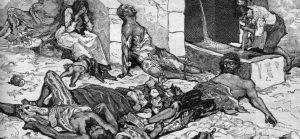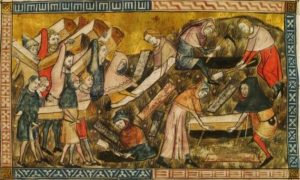There is no denying that the current Covid-19 pandemic has had a major impact on human life. The entire lifeline was instantly paralyzed in a short period of time. However, disease outbreaks are nothing new in human history. From the perspective of various historical periods, the outbreak of diseases seems to be inseparable from human life itself. The same is true of the plagues of the Islamic classical period, which accompanied the development of Islamic civilization at that time. Plague in the classical period of Islam are still continuations of the Justinian pandemic, which struck the Mediterranean more than two centuries ago.
Many theories suggest that the plague helped advance Islamic civilization while also weakening Byzantium. But on the other hand, Muslims were also plagued by the plague, as evidenced by the many mass deaths that occurred during the Islamic Classical period. During this period, at least five major plagues hit the Islamic world.
The Emergence of the Plague in the Classical Period of Islam
According to the Greek historian Procopius, in the summer of 541, a deadly infectious disease emerged in the Egyptian port city of Pelusim. The disease caused by Yersinia pestis spread rapidly eastward, along the coast to Gaza, and westward to Alexandria (Procopius, 1914:453).
By the summer of 542, the disease proved to have spread to Constantinople, the capital of the Roman Empire (Procopius, 1914:455).By the summer of 542, the disease proved to have spread to Constantinople, the capital of the Roman Empire (Procopius, 1914:455). When someone is exposed to the disease, the initial symptoms they experience are limited to a fever. After a few days, symptoms worsen with swelling of the body part. The swollen part then blistered, turned black and filled with pus. When patients become aware of these late symptoms, it means they are too late. The bacteria have spread throughout the body and the patient will soon die.

In Constantinople, the plague raged, killing some 300,000 people in a year. Even the Byzantine Emperor Justinian was affected by the plague, although he eventually recovered. Still, his military ambitions could not be restored. The mass death caused by the plague thwarted his ambitions to capture the western provinces and restore the Roman Empire to its former glory (Khon, 2008:216).
For nearly two centuries, the disease has never completely disappeared from the Middle East. Just when the disease was thought to be gone, the plague reappeared and caused massive deaths. One of the severely affected regions is the Arab region. When Islamic civilization began to develop in Arabia, there were at least five great plagues.
Plague of Shirawayh
This plague is considered to be the first plague of the classical period of Islam. The center of the plague, which occurred in 627-628, was in Ctesiphon (al-Mada’in), the capital of Persia. Hence the name of the plague was taken from the name of the Persian king Siroes, who also died of the plague in 629 (Dolls, 1977:20).
At-Tabari mentioned that so many Persians have died in the epidemic. The testimony of the plague that occurred at the beginning of Islam was not written in the 7th century. The lack of a writing tradition in that century led to new records of the plague being written in the following centuries. As a result, little data is available, and there is uncertainty about the number of victims and how the outbreak began.
Plague of Amwas
The most famous plague of the classical period began to infect the Muslim army camp in Amwas, Palestine, in January and February 638, followed by a second wave the following year that spread across Syria.
The epidemic coincided with the severe famine that struck Syria and Palestine, and was thus called the year of Ramadan (al-Tabarai, 1989:151). The famine reduced the body’s immune system and attracted plague-infected mice to residential areas in search of food. As a result, humans come into contact with mice that carry a lot of bacteria. In the end, the plague quickly spread throughout Syria.
According to historical records, the plague killed around 25,000 Muslim soldiers. Many of the Prophet’s companions died of the Anwas plague, including Abu Ubaidah, Yazd ibn Abi Sufyan, Muad ibn Jabbar and his sons.The effects of the plague were severe, and panic spread among the Muslim army. Even so, they didn’t do much when the pandemic hit. To deal with the plague, they only relied on the three principles taught by the prophets to deal with the plague
- The plague is a form of mercy and martyrdom for devout Muslims; and punishment for unbelievers.
- Muslims are not allowed to enter or escape the affected area.
- The plague did not spread because the disease came from Allah.
When the plague began to hit Amwas, Abu Ubaydah and his troops believed that the plague was the mercy that Allah had destined for them, so the Muslim army of Amwas persevered and did not do much (Dolls, 1974:377).
Caliph Omar, who heard the news, immediately rushed to Syria to check the situation. When he arrived in the city of Sargh, he heard the news that the plague had spread in the Syrian-Palestinian area and had caused a large number of deaths.

Omar then convened the Muhajirin Council (including Abu Ubaidah) and Ansar to discuss the matter. Abdurrahman ibn Auf reminded Umar that the Messenger of Allah was forbidden to enter the areas affected by the plague.
After hearing various opinions, Omar finally decided to return to Medina with his entourage. Abu Ubaydah protested the decision, seeing it as an attempt to evade Allah’s decree. Umar replied that he had fled the decree of Allah for another decree of Allah (al-Tabari, 1989:93).
On the way back to Medina, Omar was still trying to overcome the plague. His priority is to prevent epidemics and quell panic among Muslims. For this reason, he took the time to meet the village chief of a Muslim settlement, gave instructions on how to bury the bodies of plague victims, and provided information about the epidemic (Doles, 1974:378).
In 639, a second wave of plague hit Syria. Omar again asked Abu Ubaidah to return to Medina to prevent his death. But Abu Ubaidah again refused and opted to stay with the Syrian army.Omar eventually ordered Abu Ubaidah to move the soldiers from the infected area in Jordan to the safer area of Howland, on the “al-Jabiah” plateau. But on the way, Abu Ubaidah himself died of the disease (al-Tabari, 1989:99).
Plague of al-Jarif
Between 688 and 689, the Jarif plague swept the Basra region of southern Iraq like a flood. The peak of the al-Jarif plague occurred in Shawwal 69/April 689. For three days in a row, 70,000, 71,000 and 73,000 people died in the city. Most of the victims of this plague died within a short period of time (mainly the fourth day after infection).
Due to the high number of deaths, burying the bodies has become difficult. The mass deaths have come at the same time as the threat of looting and wildlife, with attempts to lock down homes where occupants have died.
Plague epidemics also occurred in Syria and spread to Egypt. Ibn Kathir noted that during the epidemic, the Egyptian governor, Abd al-Aziz ibn marwan (65-85/685-704) fled to ash-Sharqiyah province for safety (Dols 1974: 379).
The plague al-Fatayat and the plague al-Ashraf
The al-Fatayat epidemic hit the Basra region in 706. It was called the plague of al-Fatayat because the victims of most deaths were young women. Due to the plague, many residents of the city of Basra fled.
And the fifth pandemic is the al-Ashraf plague. The plague hit Iraq and Syria during 716-717 in Iraq and Syria in 716-717. The epidemic of the plague coincided with the repression by the Iraqi Umayyad Governor al-Hajjaj ibn Yusuf. Many important people have died due to this epidemic.
One of them was Crown Prince Ayub ibn Suleiman ibn Abdul Malik, who died of the plague. Meanwhile, Ayub’s father, Caliph Suleiman, is trying to escape the plague. However, he died (probably from the plague) in the Dabiq area in October 717 (Doles, 1974:379).
The Influence of the Plague on the Classical Period of Islamic Civilization
It is hard to deny that one of the real effects of this recurring plague was the weakening of the Byzantine and Sassanid powers in the Middle East. The outbreak, estimated by Josiah Russell between AD 541-700, reduced the Euro-Mediterranean population by 50-60% (Russell, 1968: 180).
The higher mortality rate than the Arabs caused the Byzantines to continue to weaken, while the Arabs continued to grow in power, especially in the time of the Prophets.
But on the other hand, the plague also hurt the Arab expansionist forces that were attacking Byzantine territory. During the Umayyad dynasty, plague is recorded to have thwarted attempts to siege Constantinople twice, in 668 and 717 (Mango and Scott, 1977:456). Thus, the Byzantine Empire has been in the golden age of Islam.
As for the internal politics of Muslims, the plague played a major role in the decline of the Umayyads and the rise of the Abbasids.The Umayyad dynasty was really hurt by this plague. Muawiyah II died of the plague in 683, just a few months after the start of his reign. Some informants claim that Caliph Marwan died of the plague. The plague also struck other government elite figures, such as Ziyad bin Abi Sufyan, who died in Kufa in 673 (Dols, 1974:380).
For this reason, when the summer plague season arrived, the Umayyad caliphs tended to leave the city and live in desert palaces close to the Bedouins. As a result of this exile, their government has been disrupted, not to mention the continued decline in the population exacerbated by it.The Syria-Palestine region and Iraq have more outbreaks than Egypt and Persia. The ongoing outbreaks have led to a slowdown in population growth.
Meanwhile, the Arabs living in the Persian region were less affected by the plague. Thus, while the power of the Umayyads weakened, the power of the Abbasids continued to grow. So it is not wrong to say that the plague made it easier for the Abbasids to gain power.
Bibliography
Al-Tabari. The History of al-Tabar Vol. 13i: The Conquest of Iraq, Southwestern Persia, and Egypt. New York: University of New York Press, 1989.
Dols, Michael W. “Plague in Early Islamic History.” Journal of the American Oriental Society, vol. 94, no. 3, 1974, pp. 371–383.
DOLS, MICHAEL WALTERS. The Black Death in the Middle East. Princenton: Princeton University Press, 1977.
Kohn, George C (Ed.). Encyclopedia of Plague and Pestilence: From Ancient Times to the Present. New York: Info Base Publishing, 2008.
Mango, Cyril; Scott, Roger. The Chronicle of Theophanes Confessor. Byzantine and Near Eastern History, AD 284–813. Oxford: Oxford University Press, 1977.
Procopius. History Of The Wars, Books I And II. London: William Heinemann Ltd, 1914.
Russell, Josiah C. “That Earlier Plague”. Demography, vol. 5, no. 1, 1968.